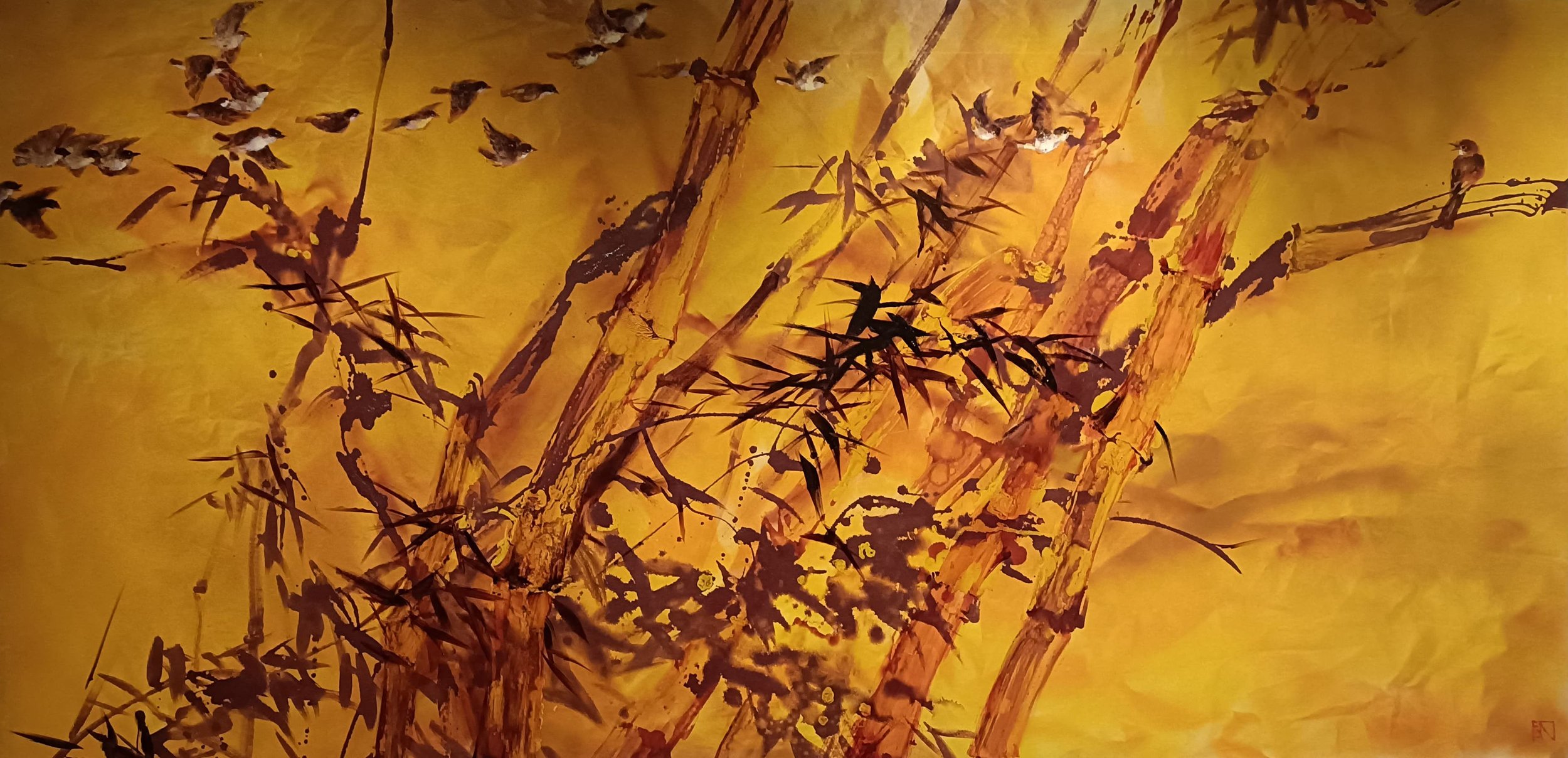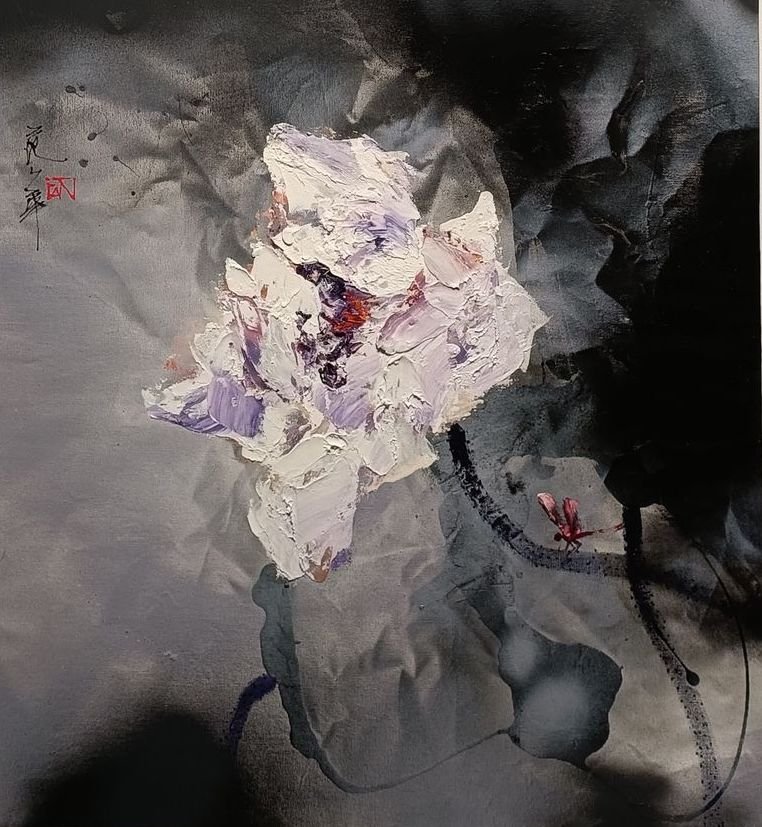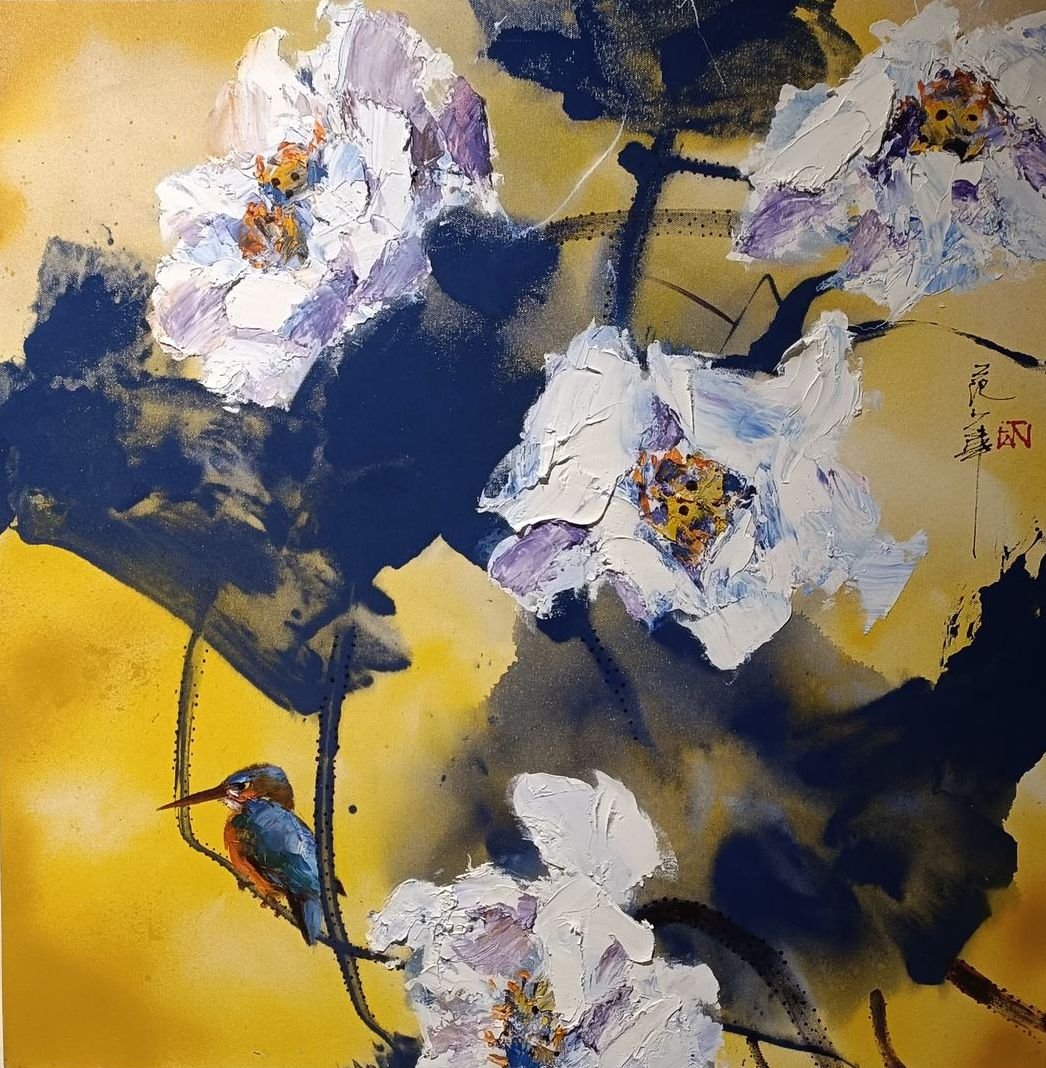Fan Shao Hua (b.1963)
Fan Shao Hua was born in 1963 in Guangzhou, China. He started Chinese ink painting at a tender age of 10 at the Secondary School of Fine Arts. Subsequently, he graduated from the Guangzhou Academy of Fine Arts in 1985 with a Bachelor of Arts.
Besides being the prestigious winner of the ‘Painting of the Year Award’ at the 19th UOB Painting of the Year Competition in 2000 and the International Premium Oil Painting Artist Award in Hong Kong in 2008, Fan has won numerous art awards and held many exhibitions overseas through the years in Hong Kong, Malaysia, Taiwan, Korea, Japan, and Paris.
For the period of 8th July running till 30th September 2022, the highly celebrated Fan Shao Hua is holding an exclusive exhibition, titled ‘Seasons of Life’ at Park Royal Hotel on Beach Road, Singapore. Goshen Art Gallery warmly invites you to revel in his artistic creations, as we write about some of his paintings that are on display during this period to let you experience a taster and a deeper understanding of the motives behind his stunning series of artworks.
‘Oriental beauty’, Oil on canvas, 100 x 200 cm
In traditional Chinese culture, the bamboo is a symbol of Oriental beauty that represents the character of moral integrity, resistance, modesty and loyalty. It also stands as an example of loneliness and elegance, among others. This value becomes one of the major themes in Chinese painting, calligraphy and poetry.
A largely monochromatic piece, ‘Oriental Beauty’ shows us a brazen display of deep cadmium yellow, complemented by the formations of the bamboo plant composed by Fan’s skilful strokes of burnt umber. Using the ‘shui-mo’ technique of traditional Chinese painting, which is considered the freestyle method in contrast to the meticulous ‘gong-bi’ style, Fan Shao Hua knows how to create the appearance of precise natural spectacles of nature, such as the bamboo shoot and its distinct, sharp edged leaves using fast and diligent strokes of his brush and other artistic apparatus.
In this painting, we witness the serendipitous flight of a flock of sparrows, flying through a spectacular bamboo-laiden landscape. The migration of birds is usually done with intention to seek areas of high resources, or to escape those of lower resources that may come about in the winter. If not for migration, birds may be flying in flocks to help notice and defend against predators, as they can all look in different directions to see threats. Either way, their flight signifies a transition from one space to another.
Transition is always, and forever will be a prevalent feature of the changing of seasons, and also very much a prevalent feature of life itself. Like birds in migration, we may find ourselves moving away from an old lifestyle that doesn’t suit us, perhaps an old space or a partner that we have outgrown. As stated wisely by the Greek philosopher Heraclitus, ‘Change is the only constant in life’.
‘Nobility’, Oil on canvas, 60 x 185cm
As we look at this painting, titled ‘Nobility’, one may ponder on the meaning of this word, which is usually used to describe somebody of fine personal qualities or of high moral principles. As a term so esteemed that is often associated with titles of aristocracy, nobility can be a rare quality to find in our everyday people. Despite being an uncommon attributive gem, perhaps having the quality of nobility is a season of life we could all aspire to, albeit one that could be considered a road less traveled. One could go on to say that it is one that can only truly be known and understood as we grow in maturity.
On an aesthetic front, the subtle overlay of purple in the background utilize Fan’s signature crinkle effect, taking the appearance of hand-dyed fabric, while a deeper, richer indigo, almost kin to the black of the nights sky in the foreground really emphasizes the stark white lotus flowers in comparison. The textured backdrop is also contributive to a great deal of illusionistic depth in this artwork.
As we look to the far side of the painting, we see an aura of warmth emanating from a glow of yellow - one that attracts the eye and brings the viewer closer to the painting, both visually and perhaps even emotionally as well. Quite literally, warm colours give the appearance of colours being nearer to us due to their shorter wavelengths, while cooler colours such as blue tend to have the effect of receding or going back in space because they have longer wavelengths that take longer to reach our eyes.
While this warm glow of yellow adds a sense of visual and emotional warmth to the painting, the dark streaks of deep purple and indigo imply a sense of depth and mystery. Like the comings and goings of life, our emotions can ebb and flow between warmth and coolness, such as the natural seasons do. Emotions are abstract and can sometimes be hard to put into words, which is why artistic masters like Fan Shao Hua have developed their complex inner worlds into a unique visual language and vocabulary of their own.
We also see the appearance of two kingfishers, one making flight perhaps on its way to find food or attend to one of the many callings of nature. The other is perched peacefully, and facing frontally to the viewer bearing his small, yet regally puffed chest that bears a striking display of yellow feathers.
As usual, the white flowers remain; although essential a foreground feature, these different elements all work together harmoniously to create an artful masterpiece.
‘Summer Lovers’, Oil on canvas, 100 x 150 cm
The Chinese believe that ducks, particularly mandarin ducks mate for life, a belief that has spread to the Japanese, Koreans and Vietnamese. That is why pairs of mandarin ducks are often denoted to symbolize the love of devoted couples.
Yuanyang is the Chinese name for the mandarin duck, scientifically known as the Aix galericulata, where yuan refers to the beautifully plumed male bird and yang the plainer female one. An interesting fact to note might be the irony that mandarin ducks do not mate for life at all, and the yuan are actually deadbeat dads who leave once the ducklings hatch.
Scientific facts aside, 14 centuries of cultural and linguistic habits means that yuanyang as a metaphor for romantic love is likely to stay - hence the naming of this painting, “Summer Lovers”. After all, what more idyllic season than that of summer is there to find ourselves lucky in love?
‘Loyalty’, Oil on canvas, 120 x 100 cm
With expressive swashes of stark black paint splayed across a shimmering golden background, ‘Loyalty’ is a dignified painting that lives up to the high attributes of its name. Here we see two of Fan’s beloved lotus flower; one smaller, younger and yet to experience itself in full bloom. The other, a fully bloomed white lotus flower that has reached full maturity; its petals beautifully opened, revealing the carpel within, which is the center of a flower.
Although every journey is unique, there are certain worldly laws that life makes no exceptions for. We start out young, grow older, and eventually return to the earth or to spirit when our time in this world is complete. For some, experiencing themselves ‘in full bloom’ can come at varying stages of our life. Growth is never linear, nor is it something that is merely physical, but rather spiritual, emotional and mental as well - at least for the human journey.
We can grow, learn, and perhaps even fall back a couple of times. But like the wonderful lotus flower, we could seek to power on in the face of adversity and challenges, in the same way that it surges through the muddy waters to reach the light of the sky. In other words, falling down is forgivable, but remember to pull ourselves up again. This way, we may find ourselves experiencing our own bloom, again and again.
‘Tranquility’, Oil on canvas, 116 x 91cm
Here, Fan Shao Hua uses a surreal overlay of elements here as we notice the suggestion of mountains, next to largely painted lotus flowers, that almost seem to challenge the mountainous landscapes in size.
This surrealistic effect is almost indicative of a mental landscape, as the artist is flooded with a mirage of memories depicting his beloved scenes from nature that become almost inseparable from his very being, after having spent so many cherished moments in the Chinese wilderness.
Another explanation for the surrealism surrounding the Lotus flower that towers above the mountain in size, could go to show his very devotion to this spiritually symbolic flower, that we see in Fan Shao Hua’s painting time and time again. Though mountains are not devoid of symbolic virtues, usually signifying strength and grandiosity, the largeness and overpowering aspect of the gentle lotus flower in this painting could be telling of the artists conviction in his connection to spirituality, since the lotus flower has many associations with enlightenment and purity.
For ‘Tranquility’, our eyes enjoy a feast of a visual journey as we are met with a varied pallet of peaches, deep reds and gradients of teal.
“Modesty”, Oil on Canvas, 60 x 55cm
“Intelligence”, Oil on Canvas, 60 x 55 cm
One could say that intelligence and modesty are two aspects that compliment one another. Similarly, the paintings of Fan Shao Hua titled “Intelligence” and “Modesty” are complementary to each other in a variety of ways. In some sense, these paintings are like two sides of the same coin, however not exactly the same.
When we speak about these qualities in the sense of them being attributive, those who are modest, perhaps in dressing or in demeanour may often be perceived as being a sign of intelligence. Take for example, fashion; wearing a black turtleneck is often associated with the likes of great intellects, while the same cannot really be said about a brightly coloured holiday shirt. However, every style in visual art, fashion, architecture etc, has its own unique beauty and mood to it.
Although these paintings both use a largely muted, monochromatic colour scheme of grey, there are subtle differences between the two. ‘Intelligence’ uses a tonal variation of greys that resides near the likes of light blue, while the tonal variation of' ‘Modesty '’ is closer to that on the scale of purple or indigo, that moves towards violet on the colour wheel.
Greys do not have to be simply a mixture of black and white - they can be inclusive of many hues such as blue, green, red and yellow. Greys are understated and modest, and can have a special way of bringing a painting together, blending it in a way that is gentle to the eye - Very much like how Mr. Fan has done here. Although his signature features of fully bloomed lotus flowers are seen in these images, the beautiful gradation of greys, pale blues and indigos are reminiscent of the season of winter. Since Fan’s paintings are also very much emotive expressions of an inner landscape, we can derive from these paintings a sense of coolness, peace, and perhaps even a tinge of melancholy; like a winter of the soul.
“Enlightenment”, Oil on Canvas, 60 x 60 cm
In contrast to the peaceful melancholy of the previous two paintings, ‘Enlightenment’ is a painting that is vibrant and high-spirited, as we are gushed with a beautiful invitation of yellows and not just one, but four lotus flowers in full bloom. Fan’s suggestion of lotus leaves is done artfully using navy blue, as he combines both elements of traditional and contemporary Chinese painting. His subject matter and foundational learning adhered to the former, while his arrangement of elements in his paintings is very much contemporary.
Enlightenment can mean having learnt something, or being freed from ignorance and misinformation. The term has strong references to The Age of Enlightenment in the 18th century, which was a philosophical movement characterised by belief in the power of human reason and by innovations in political, religious and educational doctrine. There are many great philosophical thinkers that arose from the Age of Enlightenment, including Francis Bacon, Renee Descartes and some of the important thinkers from the Scientific Revolution such as Galileo and Kepler.
Imagine the moment of having a spectacular idea or innovation, usually symbolised by the famous lightbulb on top of one's head. Every great thinker would have had an ‘aha’ moment of enlightenment, whether it was Nicolas Tesla when he invented electricity, or Isaac Newton when he discovered gravity, and so on. Imbued with the colour yellow, just like the lightbulb, we could infer that Fan Shao Hua is painting what a moment of discovery, innovation or being freed from ignorance could feel like. Yellow is a distinct colour associated with enlightenment, confidence, happiness and optimism. Who knows, perhaps with the company of this painting, it could help you get an ‘aha’ moment of your own.
“Prosperity”, Oil on Canvas, 50 x 100 cm
Using a beautiful wash of emerald and jade green, what we see before us is an image that is refreshing and revitalising. There is a great significance to the colour of jade green and its linkage to prosperity and good luck.
Jade symbolism includes associations with nobility and wealth. Many consider it a protector of generations, living and dead. Jade has been and always will be the “Gem Supreme” and the “Jewel of Heaven,” stone of the heart.
‘Prosperity’ is a wonderful painting that draws us in not only in its vibrant colour, but attractive abstract assemblage and textures. Fan uses a multifaceted approach to his paintings, likely using different methods such as wet paint transfer using cloth or fabric, which is what creates these enchanting abstract patterns full of depth and layering.
“Resilience”, Oil on Canvas, 90 x 120cm
‘Resilience’ is a dynamic composition of various elements; splashes of deep red that are laid atop of its contrasting complementary colour, with various shades of greens and blues - all on top of an imperial golden background. These colours are all expressively amalgamated in a way that aims to represent the boundless human spirit.
The lotus flower has often been a symbol associated with resilience as it surges through the muddy waters to reach the light of air. Here, Mr. Fan speaks clearly using his visual language of colours and brave strokes. While some of his paintings communicate softness and gentility, this one communicates boldness, emotional power, breadth and regality. As an explorative contemporary painter, his artistic expertise reaches far beyond the limits of a paintbrush, as he has likely used a combination of paint transfer and various large tools that scrape across the surface of the canvas to create his distinct textural elements.
“Double Happiness”, Oil on Canvas, 116 x 91 cm
It is likely no surprise that the kingfisher is a symbol of beauty, and in China apparently it is a compliment for women to have ‘kingfisher eyebrows’. Given their habit of hunting in pairs, kingfishers also represent married love.
Here, we see peaks of Fan Shao Hua’s roots in realism peaking through, as these kingfishers are painted in full realistic detail. The same goes for the white lotus flower pictured here, painted in realistic detail here where it is usually painted using a more freestyle, impasto approach in many of his other paintings. This makes ‘Double Happiness’ a rare painting in Fan’s repertoire. Happiness is suggested here through the sighting of two kingfishers and the gentle unfurling of the lotus petals which we see blowing in the wind. We get a sense of contentment and satisfaction from this painting through the muted golden-brown background, which is both unassuming yet highly dignified.
“Transcendence”, Oil on Canvas, 120 x 90 cm
As mentioned before for one of the previous paintings, ‘Summer Lovers’, the sighting of two mandarin ducks is said to represent long-term, devoted love. The male duck boasts a beautiful plumage of coloured feathers, while the female ducks tend to be plainer in appearance.
‘Transcendence’ is an eclectic assortment of figurative and abstract elements, one of Fan’s recurring stylistic features. Whereby the stems of the lotus leaves are merely suggested in his other paintings through the use of black and navy blue, almost taking the appearance of a shadow, he has gone a different stylistic route in this painting as he has painted them in olive green and included the dotted details of the stem’s natural texture, almost as if it were shone on by the light of day in this instance. Eclectic combinations of pinks and greens are suggestive of a sweet romance, while the manner in which he uses a thinner, watery method of abstractedly applying washes of paint are indicative of transcendental states.
“Honour”, Oil on Canvas, 50 x 100 cm
“Honour” is a smaller, yet characteristic painting of all his famous elements; the in-depth, paper crinkle effect in the background, the traditional elements of the lotus flower and bird, and his abstracted, contemporary representation of lotus leaves shown using black and light blue.
In this painting specifically, there can be a lot of distinction made between the thinly washed background and thicker foreground features that use impasto techniques, both bringing emphasis to one another.
The idea of honour is deeply engrained into Chinese culture. To honour means to regard or treat someone with admiration and respect, which is shown evidently in the way that children are expected to obey their parents and honour their elders in traditional Chinese culture. This is in accordance with filial piety, the Confucian tenet that stresses the importance of age. For example, in most regions of China, the entire family is expected to consult family elders when making big decisions. Moreover, children are often expected to care for their parents as they age.
“Eternity”, Oil on Canvas, 50 x 100 cm
This laterally elongated piece, titled ‘Eternity’, shows overlays of vivid, textured black, and for added depth, gradients of misty greys. The wide format allows us to admire the piece through a certain lens, and we get a sense of solitude from the bird that is emphatically perched in front of a full moon. Fan also brings our attention to the beauty of a single bird not only by its illumination by the light of the moon, but also because it is the only element of bright colour within the whole painting. Its composition is also carefully thought out due to the placement of these focal elements, which are slightly off-centre, leaving space for ambiguity and beauty. Meanwhile, the expressive arrays of black and grey textures also rapture our attention, as they vividly capture the mysteries of nightfall.
In Chinese tradition, the full moon is a symbol of peace, prosperity, and family reunion. On the 15th day of the 8th month of the lunar calendar, the moon is full and it is time to mark the Moon Festival, or the Mid-Autumn Festival. The round shape can often symbolise family reunion.
Additionally, traditional Chinese culture would also describe the moon as a carrier of human emotions. Ancient Chinese mythology and philosophy explain why the Chinese have such a preferential liking for the moon, such as through famous stories about Chang E, the moon goddess and her jade rabbit.














